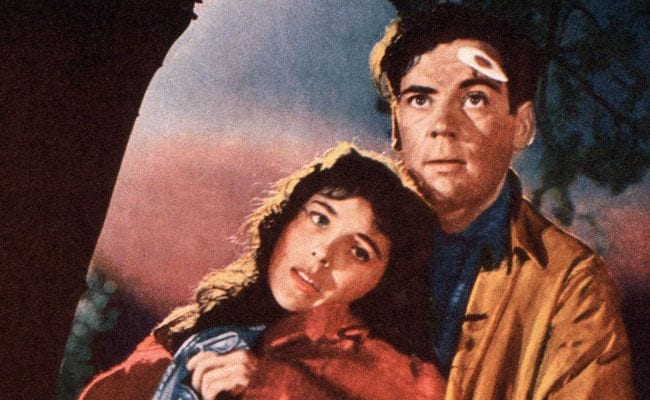
William Cameron Menzies (1896-1957), was one of the great influential production designers in cinema; indeed, the term “production design” was coined for his work on Gone with the Wind (1939). Yet, he was less prepossessing as a director because of failings common to art directors turned directors: he tended to use actors as design elements rather than encourage performances from them, and he tended to pay more attention to “the look” than the story and pace. Even so, he directed two remarkable if imperfect examples of ’50s Cold War paranoia: Invaders from Mars (1953) and the earlier The Whip Hand (1951), which is now on demand from Warner Archive.
A blandly pretty, young Elliott Reid plays Matt Corbin, a reporter who goes fishing near a small town and smacks his head against a boulder. Late in the movie, he’ll smack the other side of his head against a branch and start bleeding all over again from a fresh wound. What a clumsy fellow! When he goes for help, he finds himself a prisoner of taciturn, falsely friendly, or just openly hostile locals who have taken over the town since all the lake fish died from a mysterious virus. What’s going on? It has something to do with the lodge across the lake, and Matt smilingly blusters his way into trouble while romancing a nervous local sweetheart (Carla Balenda).
In two major respects, The Whip Hand can be measured as a noir film: it’s one of the hundred movies where Raymond Burr plays a bad guy, and it’s dominated by the masterful chiaroscuro photography of Nicholas Musuraca. The shadowy close-ups, cramped compositions, and low or high angles are to die for. The threadbare town, the natural forest, and the picturesque lake (shot at Big Bear Lake) are all threatening and claustrophobic.
Alas, as we witness an interminable and style-free lecture in bad Russian, it’s already spilled in the first scene that some kind of communist plot is underfoot at the Kremlin’s direction. This scene and other highly expository ones, like the distant shot where an editor dictates a message just before we see it word for word on a teletype, come clodhopping into the picture from another director, Stuart Gilmore, for reasons explained by James Curtis in his new book: William Cameron Menzies: The Shape of Films to Come.
In 1950, writer-producer Stanley Rubin made a movie called The Man He Found, in which it turns out that a crazy, half-burned Adolph Hitler is still alive and hiding at a lodge in Wisconsin! With his meticulous storyboard sketches and uncanny planning for atmosphere, Menzies brought in the thing with great style and under budget. Then RKO owner Howard Hughes said Hitler was yesterday’s news and ordered the film rewritten with more topical “commies” working on germ warfare instead. Rubin removed his name as new producer Lewis J. Rachmil took over for reshoots spanning several months. The revised and retitled movie, changed to The Whip Hand, was eventually released the following year, when Variety ranked it as “perhaps the best modestly-produced melodrama of the season … For William Cameron Menzies, who designed the production and directed, pic is a work of art.”
This twisted history helps explain the jarring scene where our upstanding young American hero suddenly strangles a model Aryan thug (Michael Steele) to death with his bare hands after sneaking up behind him, the brutality of which seems unusual and unmotivated for Hollywood product of the time. It also explains why we now have a Nazi scientist (Otto Waldis) spouting German-accented rhetoric about the glories of communism — which hardly seems loyal to Hitler’s memory — before Matt offers a good sock to the jaw.
We don’t know if the original cut made more sense than the protracted yet perfunctory ending on this new version. Most importantly, The Whip Hand retains the credit “Production Designed and Directed by William Cameron Menzies,” and this explains why even an interfered-with item is worth our attention. It’s one of those occasional B films where the suggestive image is more valuable than the blunt script.
Also in the picture are Edgar Barrier as the ambiguous sawbones with thick glasses, Lurene Tuttle as the nosy switchboard operator, Frank Darien as the one honest old codger in town, Peter Brocco as a goon, Lewis Martin as the elegantly patrician villain behind the scenes, and Olive Carey giving possibly the subtlest performance as a local farmer’s wife.
The Warner Archive print has no extras, but it looks swell.

